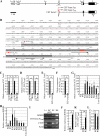Expression of a testis-specific form of Gal3st1 (CST), a gene essential for spermatogenesis, is regulated by the CTCF paralogous gene BORIS
- PMID: 20231363
- PMCID: PMC2863697
- DOI: 10.1128/MCB.01093-09
Expression of a testis-specific form of Gal3st1 (CST), a gene essential for spermatogenesis, is regulated by the CTCF paralogous gene BORIS
Abstract
Previously, it was shown that the CTCF paralogous gene, BORIS (brother of the regulator of imprinted sites) is expressed in male germ cells, but its function in spermatogenesis has not been defined. To develop an understanding of the functional activities of BORIS, we generated BORIS knockout (KO) mice. Mice homozygous for the null allele had a defect in spermatogenesis that resulted in small testes associated with increased cell death. The defect was evident as early as postnatal day 21 and was manifested by delayed production of haploid cells. By gene expression profiling, we found that transcript levels for Gal3st1 (also known as cerebroside sulfotransferase [CST]), known to play a crucial role in meiosis, were dramatically reduced in BORIS KO testes. We found that CST is expressed in testis as a novel testis-specific isoform, CST form F(TS), that has a short exon 1f. We showed that BORIS bound to and activated the promoter of CST form F(TS). Mutation of the BORIS binding site in the promoter reduced the ability of BORIS to activate the promoter. These findings define transcriptional regulation of CST expression as a critical role for BORIS in spermatogenesis.
Figures






Similar articles
-
Discovering a binary CTCF code with a little help from BORIS.Nucleus. 2018 Jan 1;9(1):33-41. doi: 10.1080/19491034.2017.1394536. Epub 2017 Dec 5. Nucleus. 2018. PMID: 29077515 Free PMC article. Review.
-
Conditional expression of the CTCF-paralogous transcriptional factor BORIS in normal cells results in demethylation and derepression of MAGE-A1 and reactivation of other cancer-testis genes.Cancer Res. 2005 Sep 1;65(17):7751-62. doi: 10.1158/0008-5472.CAN-05-0858. Cancer Res. 2005. PMID: 16140943
-
The combined action of CTCF and its testis-specific paralog BORIS is essential for spermatogenesis.Nat Commun. 2021 Jun 22;12(1):3846. doi: 10.1038/s41467-021-24140-6. Nat Commun. 2021. PMID: 34158481 Free PMC article.
-
Reciprocal binding of CTCF and BORIS to the NY-ESO-1 promoter coincides with derepression of this cancer-testis gene in lung cancer cells.Cancer Res. 2005 Sep 1;65(17):7763-74. doi: 10.1158/0008-5472.CAN-05-0823. Cancer Res. 2005. PMID: 16140944
-
The novel BORIS + CTCF gene family is uniquely involved in the epigenetics of normal biology and cancer.Semin Cancer Biol. 2002 Oct;12(5):399-414. doi: 10.1016/s1044-579x(02)00060-3. Semin Cancer Biol. 2002. PMID: 12191639 Review.
Cited by
-
Discovering a binary CTCF code with a little help from BORIS.Nucleus. 2018 Jan 1;9(1):33-41. doi: 10.1080/19491034.2017.1394536. Epub 2017 Dec 5. Nucleus. 2018. PMID: 29077515 Free PMC article. Review.
-
The male germ cell gene regulator CTCFL is functionally different from CTCF and binds CTCF-like consensus sites in a nucleosome composition-dependent manner.Epigenetics Chromatin. 2012 Jun 18;5(1):8. doi: 10.1186/1756-8935-5-8. Epigenetics Chromatin. 2012. PMID: 22709888 Free PMC article.
-
Genetic diversity and population structure of six autochthonous pig breeds from Croatia, Serbia, and Slovenia.Genet Sel Evol. 2022 Apr 28;54(1):30. doi: 10.1186/s12711-022-00718-6. Genet Sel Evol. 2022. PMID: 35484510 Free PMC article.
-
Defining the relative and combined contribution of CTCF and CTCFL to genomic regulation.Genome Biol. 2020 May 11;21(1):108. doi: 10.1186/s13059-020-02024-0. Genome Biol. 2020. PMID: 32393311 Free PMC article.
-
BORIS Expression in Ovarian Cancer Precursor Cells Alters the CTCF Cistrome and Enhances Invasiveness through GALNT14.Mol Cancer Res. 2019 Oct;17(10):2051-2062. doi: 10.1158/1541-7786.MCR-19-0310. Epub 2019 Jul 10. Mol Cancer Res. 2019. PMID: 31292201 Free PMC article.
References
-
- Bell, A. C., A. G. West, and G. Felsenfeld. 1999. The protein CTCF is required for the enhancer blocking activity of vertebrate insulators. Cell 98:387-396. - PubMed
-
- Bourc'his, D., and T. H. Bestor. 2004. Meiotic catastrophe and retrotransposon reactivation in male germ cells lacking Dnmt3L. Nature 431:96-99. - PubMed
Publication types
MeSH terms
Substances
Grants and funding
LinkOut - more resources
Full Text Sources
Molecular Biology Databases
Research Materials
